Introduction
Hurricanes are capable of affecting almost everything in their paths. Their strong winds and heavy rains can directly impact both inland and coastal areas in short periods that usually last about a day. Understanding the effects of hurricanes is the first step to preparing for these weather events. Hurricanes can have extensive and potentially permanent effects on whole ecosystems. Many efforts have been made to develop ways to accurately predict, effectively prepare for, and quickly recover from hurricanes; however, the storms' sizes and complexity make this difficult. Multidisciplinary collaborations are required to improve our understanding of hurricanes. This document reviews basic facts about hurricanes and their effects in Florida and discusses ways they might affect Florida's agriculture and natural resources. Examples in this document demonstrate how weather, agriculture, environment, and ecosystem are connected to each other across spatial scales ranging from microorganisms to an entire landscape.
What are hurricanes?
Hurricanes are large, swirling tropical storms that develop over warm ocean water. Hurricanes affecting Florida usually form in the Atlantic Ocean from June to November when the trade winds are able to carry them west or northwest at a speed of 10 to 15 miles per hour (NOAA 2017a). Once hurricanes reach the latitudes of 25° to 30°N (the subtropical ridge), the westerlies usually drive them northeast (NOAA 2017d). The scientific name for a hurricane is a tropical cyclone, also known as a typhoon when it develops in the North Pacific Ocean.
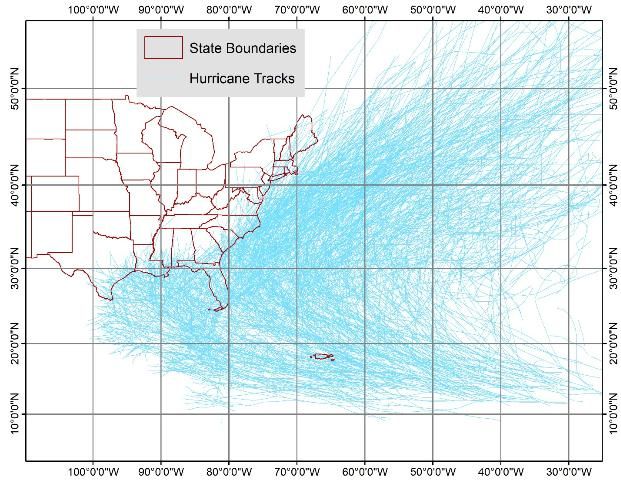
Credit: NOAA
Ocean water holds heat, which is released when water vapor evaporates from the ocean surface. This is called latent heat, and it fuels the formation and travel of tropical cyclones. Hurricanes are categorized by the sustained speed of their winds based on the Saffir-Simpson Hurricane Wind Scale (NOAA 2017c). Hurricanes in Category 3, Category 4, and Category 5 are major hurricanes. Although hurricanes are commonly associated with rainfall, the rainfall characteristics are not considered in the classification of hurricanes, presumably due to the difficulty of making accurate remote estimations of rainfall.
Hurricanes consist of the eye, eyewall, and rainbands (Figure 2). The eye is the hurricane center where skies are clear with light winds. The location of the eye is used as a reference point to track hurricanes (Figure 1). The eyewall consists of the strongest winds and thunderstorm clouds and is the most destructive part. Rainbands are long, curved groups of clouds and thunderstorms that stretch for hundreds of miles (NOAA 1999) from the eye, and they sometimes contain very strong wind and tornadoes, especially on the east side of the eye. The winds and rainfall weaken between bands compared to within a band.
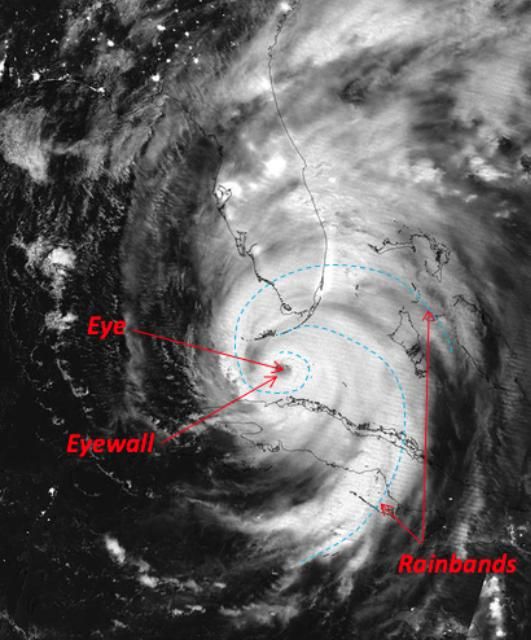
Credit: NASA
NOAA National Hurricane Center names hurricanes and tropical storms using established lists that follow the procedures maintained and updated by the World Meteorological Organization (WMO) (NOAA 2017e). Names are reused every six years, but the names of extremely destructive storms such as Andrew are retired. The main purpose of naming hurricanes is to facilitate clear and quick communications among people, institutes, stations, and bases, which is why the names are usually short, distinctive, and easy to pronounce (NOAA 2017f).
Hurricane Impacts on Florida
Hurricane landfalls are frequent in Florida, making it one of the most hurricane-affected states. Since 1851, 898 hurricanes have formed in the Atlantic Ocean, with 322 classified as major hurricanes (NOAA 2017b). The number of hurricanes has increased slightly, but with fluctuations (Figure 3). Of the 898 hurricanes, 289 made landfall on the coast of the US, and 120 of them (36 major hurricanes) affected parts of Florida (Figure 4). The data indicate that Florida has been affected by a hurricane every 1.38 years (every year to two years) on average.
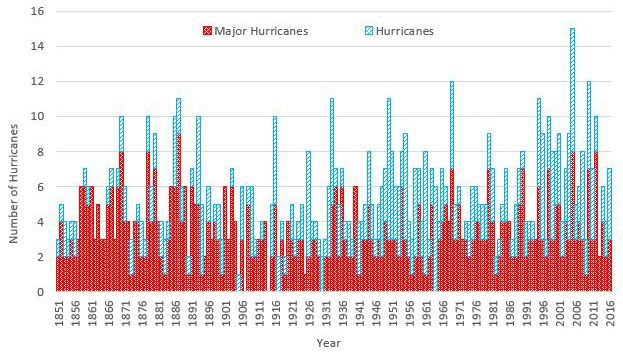
Credit: NOAA
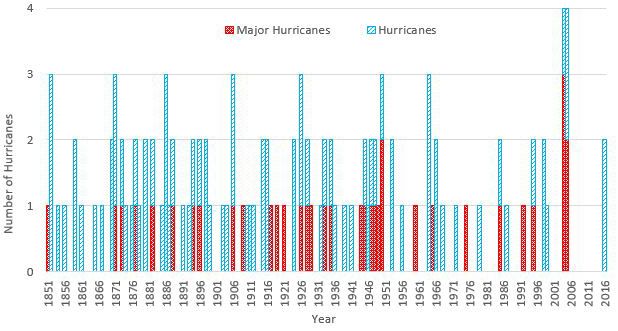
Credit: NOAA
Since 1900, Florida has had a total of approximately $526 billion (2005 USD) worth of hurricane damage, which is equal to that of the rest of the US (Pielke, Jr. et al. 2008). Major hurricanes caused 87% of the damage. The Great Miami hurricane of 1926 caused an estimated $157 billion (2005 USD) worth of damage. It is followed by Katrina in 2005 ($81 billion), Galveston ($78 billion in 1900), another Galveston ($62 billion in 1915), and Andrew ($58 billion in 1992). Florida is also the state that has been the most frequently damaged (25 times) by the top 50 devastating hurricanes, followed by Texas (11 times) and North Carolina (eight times). Hurricanes cause loss of life as well as property damages. Large amounts of rainfall brought by the 1928 Lake Okeechobee hurricane, one of the most devastating Atlantic hurricanes on record, damaged the earthen dam of Lake Okeechobee and caused extensive flooding in its downstream areas, resulting in 2,400 deaths (Blake 1980).
Impacts on Ecosystems
Hurricanes can affect a wide range of terrestrial and aquatic ecosystems as well as the associated ecosystem services, or benefits people obtain from nature to improve their livelihood. In terrestrial ecosystems, the strong wind generated by the hurricane can substantially affect the structure and functioning of coastal forest and wetland ecosystems, including upland forests, mangrove swamps, hardwood hammocks, sawgrass, and forested wetlands. Because of the proximity of these ecosystems to coastlines, these ecosystems often sustain dramatic damages from hurricane winds. Impacts often include uprooting of trees and complete removal of leaves and branches. Besides direct wind impacts, storm surges can also transport large amounts of saline water and sediment inland, which can lead to additional physiological stresses (salinity or oxygen) to plants. In 1992, for example, Hurricane Andrew in south Florida caused significant damage to the mangrove forests of the Everglades (Roman et al. 1994), with almost 100% visual structural damage observed and about 60% of the trees uprooted or broken due to combined effects of high wind speed and tidal surges.
The loss of mangrove forests leads to loss of carbon that is released to the atmosphere, destabilization of shorelines, and reduction of critical habitats for many endangered species (e.g., Key deer, American crocodiles, hawksbill sea turtles, etc.). Moreover, changes in abiotic conditions (such as light, temperature, and humidity) due to losses of forest canopy can also have profound implications for other species such as birds and lizards in terms of food sources, habitat suitability, and increased predation risks. Destruction of vegetation can cause a large influx of litterfall in the form of fallen leaves, branches, and other natural debris into aquatic systems. For Hurricane Andrew, it was estimated that 41% of the normal seasonal litterfall occurred during the one day of the passage of the hurricane (Roman et al. 1994). Such an enormous flow of organic materials into the coastal water can lead to abnormally high levels of nitrogen, phosphorus, potassium, and other nutrients for these ecosystems. The decomposition of this organic matter can lower the amount of oxygen in the water column and lead to large kills of aquatic species, such as fish, crabs, and other invertebrates.
Impacts on Agroecosystems
The high winds and flood waters from hurricanes can have catastrophic impacts on agriculture. Total crop losses from Hurricane Irma were estimated at $2 billion, while total losses to production agriculture were estimated at $2.5 billion (FDACS 2017). A UF/IFAS survey reported Hurricane Irma damaged more than half of the agricultural and horticulture crops in seven Florida counties. Nineteen counties reported 40% of crops were damaged, and 63 counties reported some form of damage. Damages include losses of harvestable fruit, whole crops, and farm infrastructure. These damages from Hurricane Irma constitute a serious ecological and economic disturbance to Florida's agriculture. However, land planning and management can mitigate losses from future hurricanes. For example, increasing crop and plant diversity in agricultural landscapes can buffer crops from high winds and rainfall.
Disturbance is a periodic event that causes disruption or distress to entities (i.e., plants) and their systems (i.e., farms). All farmers use disturbance purposefully to maintain viable economic outputs through management practices such as tilling and pesticide applications (Vandermeer 2011). These managed disturbances are similar to natural disturbances in that they influence the growth and survival of many plants and animals, including crops and livestock, and the overall structure and dynamics of populations, communities, and ecosystems (Sousa 1984). Managed disturbances are often moderate-intensity events that deliberately provide an advantage to the crop through intentional preparation of the environment and removal of competitors in the agricultural system. These management practices improve production outcomes but also remove complexity from the agroecosystem that is necessary for the overall stability and resilience of the system (Altieri 1999). The lack of stability and resilience may then increase the intensity of ecological disturbance and economic loss from catastrophic natural disasters, such as hurricanes (Buma and Wessman 2011).
Moving forward, land planning and management for agriculture should focus on maintaining diversity and complexity in the agroecosystem through practices such as perennial crops and wind breaks. Surrounding natural areas may also be maintained as a buffer to the impacts of disturbance events, although these natural areas may also be greatly impacted by hurricanes and other major disturbance events. Additional benefits to agroecosystems, such as water and nutrient retention, pollination services, and pest and disease mitigation, may arise with management for diversity and resilience to mitigate the impacts of hurricanes.
Impacts on Crops
The effects of hurricanes on crops can range from slight and temporary to profound and long-lasting, depending on conditions and crop type. In general, damage to seasonal or annual crops tends to be limited whereas damage to fruit tree orchards will be more persistent. Hurricane conditions affect crops in several ways, primarily through high wind, heavy rainfall, and/or flooding damage.
Winds can have devastating and long-lasting effects on tree orchards because they can break limbs, defoliate leaves and fruit, or even topple trees, leading to long-term crop losses. Perhaps the most evident damage following storms is that of fallen trees. This type of damage occurs when soils become saturated after heavy rain and lose the soil structure needed to support the trees. Mature trees with large canopies require a deep and extensive root system to support themselves. In south Florida, and especially in Miami-Dade County, tree orchards are more susceptible to toppling during hurricanes because soils are shallow and overlay a root-impenetrable bedrock. Pruning trees prior to hurricanes can reduce tree toppling because it reduces high wind resistance and lowers trees' center of gravity. In the case of avocados, pruning can also help trees recover from prolonged flooding (Crane and Balerdi 2015).
Prolonged flooding brought on by hurricanes causes soil pore spaces that normally contain air to fill with water and reduces oxygen availability to soil microorganisms and plant roots, causing varying degrees of anoxia or hypoxia. Plant roots require oxygen for respiration, healthy metabolism, and growth. Some plants, such as avocado, are particularly sensitive to prolonged hypoxic or anoxic conditions in which tree death can occur after only four to seven days (Schaffer, Davies, and Crane 2007). Typical symptoms include yellowing and dropping of leaves followed by limb and whole tree death, even if flooding recedes. Depending on the cultivar, other tropical fruit trees such as mango are less susceptible to prolonged flooding. This reduced susceptibility could be related to the ability of certain mango cultivars to exude toxic metabolites that accumulate during metabolism under low root oxygen conditions. Flooding tolerance mechanisms are complex and include a number of metabolic adjustments to deal with limitations in anatomy and metabolism.
Hurricane-affected areas near the coast often experience seawater flooding caused by high tides and sea surges. Floods with seawater have the added problem of high salinity. Hurricanes can cause saline water intrusion above ground or through subsurface aquifers which can inundate inland areas where high salinity is not common and expose plants to serious additional environmental stress. Perhaps the most lasting effect of hurricanes is the rapid and long-term salinization of coastal areas that are not otherwise saline. Salinity is a significant problem to agriculture and one of the most serious causes of yield loss. It often exists in arid areas where evaporation exceeds rainfall and crop irrigation is practiced for many years. Salinity is deleterious to plants due to high concentrations of sodium and chloride ions that affect plants in two ways. High concentrations of these ions outside roots effectively reduce the available water for root uptake. Sodium and chloride lower the osmotic potential around the root and reduce the ability of roots to draw water into the plant, thereby creating a water deficit similar to a mild drought. Higher concentrations of these ions also cause direct toxicity because they accumulate inside plant tissue and affect normal metabolic processes. Plants have developed several strategies to deal with toxic concentrations of salts in their tissues, and some include either extrusion back into the soil or compartmentalization of salts into specialized organs within cells known as vacuoles. However, if the concentration of salt exceeds the ability of cells and organs to exclude or compartmentalize these ions away from metabolically sensitive cells and tissue, it will result in leaf tip burning, leaf yellowing, early senescence and, if severe enough, plant death.
Impacts on Freshwater Bodies
Hurricanes bring heavy rainfall and strong winds in wide areas while passing. Large amounts of rain falling for a short time can quickly fill the storage of reservoirs and dams. Once the water level reaches a certain height, additional rainfall that comes onto the surface of reservoirs and dams will be released through the spillways so that water will not overflow and break the levees, banks, and/or dikes. In south Florida, the canal system includes pumping stations that can quickly move water and help empty reservoirs and lakes before the onset of hurricanes so these areas can hold the extra water from increased rainfall. Heavy rain falling on the ground may form concentrated flow or drain into storm water sewers and streams.
Rather than running off into streams and canals, some of the rain that reaches the ground moves into soils and then the aquifer. Florida's limestone soils allow rainwater to infiltrate quickly. Thus, standing water is not common on the soil surface even when rainfall is heavy, especially in south Florida. However, this is not the case in urban areas, as rainwater cannot penetrate pavement and concrete. This is why urban areas with wide, impervious surfaces tend to be more frequently flooded.
The heavy rainfall from hurricanes can wash soil, debris left on roads, and fertilizers applied to yards and farms to downstream areas such as lakes and estuaries. These materials that accumulate downstream can negatively impact water quality. For example, nutrients transported from land can cause algal blooms and eutrophication in the water bodies. Additionally, nutrients can move to the aquifer through soils and contaminate groundwater. Such transport processes happen even with small storm events, but a large amount of water created by hurricanes can accelerate and disturb natural processes.
While hurricanes increase the quantity of water delivered to water bodies, their high and sustained winds from one direction can push water up at one end of lakes and estuaries. The water level raised by the winds on the land around a lake or estuary is called storm surge. An elevated water level can be several feet high, depending on the strength of wind, the depth of water bodies (lakes and estuaries), and the height of sea level. The raised water can overflow banks, levees, and dikes and then flood the downstream areas of the lakes and the low-lying inland areas adjacent to the estuary, especially when hurricanes coincide with a high tide (Genovese and Green 2015; Balaguru, Judi, and Leung 2016; Hung, Wang, and Yarnal 2016). Storm surge can travel inland for miles and contaminate freshwater resources with saltwater (Miami-Dade County Board 2016). Studies show that sea level rise is likely to increase flood and saltwater risks in Florida's coastal areas in the future (Frazier et al. 2010; Wdowinski et al. 2016).
Storm surge hazard maps show areas susceptible to storm surge so that people living in or passing by those areas can be aware of flooding risks (Figures 5 and 6). A storm surge hazard map, which is prepared by national agencies (e.g., NOAA) and city/county governments (e.g., Miami-Dade County), is different from Federal Emergency Management Agency's (FEMA) flood insurance rate map that shows flood zones defined based on mitigation activities and facilities (e.g., construction of dams, levees, or seawalls) as well as topography and (extreme) weather events (Figure 7).
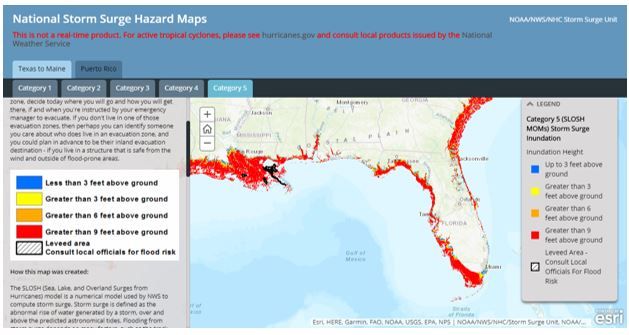
Credit: NOAA
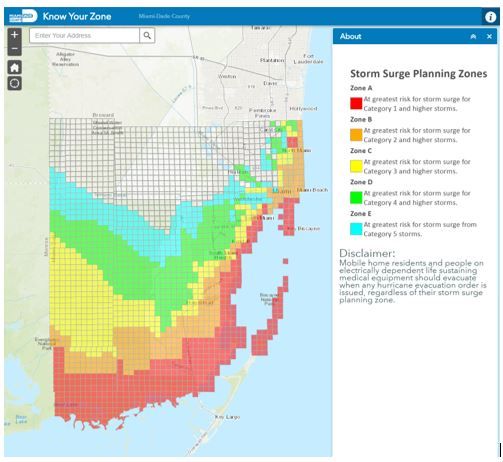
Credit: Miami-Dade County
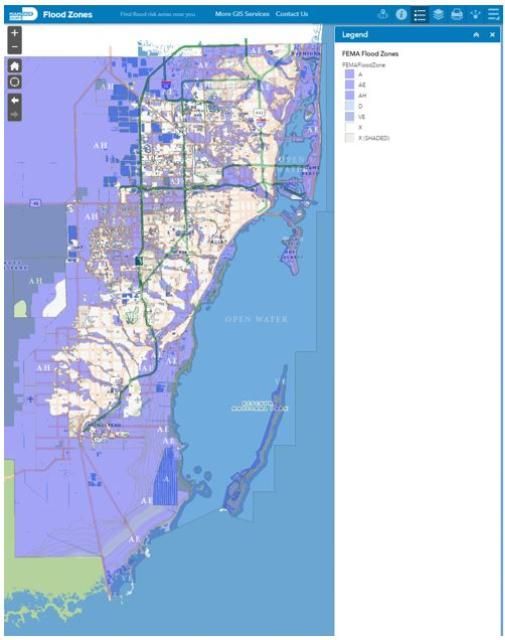
Credit: Miami-Dade County
Strong winds and rapid changes in atmospheric pressure can create a tidal wave oscillating back and forth across a lake (Chimney 2005; NOAA 2017g). This wave, known as a seiche, can intensify, causing water to overflow the banks and break dikes. A standing wave oscillating is common in large lakes such as Lake Okeechobee and the Great Lakes, but hurricanes can set up wind and atmospheric conditions that make large and dangerous seiches.
Impacts on Coral Reefs, Seagrasses, and Wetlands
South Florida's coastal and marine habitats can suffer direct or indirect impacts from hurricanes. While some of the effects are instant and obvious, others occur well after the eye of the storm has passed. Intense winds, heavy rains, and storm surge, which can pull water from beaches, leave underwater areas exposed, and push water to the shore, are a few ways hurricanes affect coastal and marine resources. Marine fish and mammals, such as sharks and dolphins, can escape to deeper water or move away from the storm. However, not all marine organisms can avoid hurricanes. Powerful storms can erode coastal plants such as seagrass beds, destroy mangrove wetlands, and break corals. These effects can have long-term consequences for the health of coastal and marine ecosystems.
Seagrass damage is commonly associated with hurricanes. The intense winds and subsequent tidal and wave energy can cause massive loss of leaf material from seagrasses and may uproot the plants completely. Additionally, the wind suspends sand and sediment, moving them into the coastal zone and occasionally covering or eroding the seagrass. The combined effects impact seagrass meadows. The conversion of seagrass meadows to unstructured and bare subtidal flats affects fisheries and water quality. Seagrass beds serve as a nursery habitat for a variety of commercially important fish and increase water clarity by trapping material as it settles from the water column. Thus, the loss of seagrass beds due to hurricanes can harm ecosystem services even after the storm has passed.
Erosion of wetlands also occurs during hurricanes. Wetlands, such as mangroves and marshes, help defend against storms. Mangroves and marshes absorb and filter water and provide habitat. However, hurricane force winds and increased wave action can cause erosion, leaving coasts more vulnerable to storm impacts in the future. Hurricanes also move sediment to wetlands, which can smother the marsh or help the mangrove or marsh accrete and keep pace with rising seas. While there has been a shift to hardened structures, such as concrete seawalls, to protect property from storms, wetlands offer natural protection by reducing the risk of flooding from storm surge. Restoration and protection of these habitats may provide a natural buffer against the effects of future hurricanes.
Hurricanes also affect coral reefs. Coral reefs can reduce the effect of storm surge. It is common to see broken and overturned corals as well as abrasions on corals after a hurricane. Damage is not restricted to hard corals. Soft corals and sponges also experience detachment, burial, or breakage. Breaking of some branching stony coral during a hurricane can be beneficial because these pieces are able to form new colonies once they settle after the storm. However, the increase in turbidity following a hurricane will limit light availability and can impact zooxanthellae. Zooxanthellae are the photosynthetic algae that live in the tissue of corals and make the corals different colors. Corals protect the zooxanthellae from the environment while the zooxanthellae provide the corals with oxygen and nutrients. Stress to the corals and zooxanthellae lead to bleaching events that can cause detrimental impacts to corals.
Hurricanes can also affect the clarity of water. Coastal waters after hurricanes are often turbid and contain small particles of sediment. The increase in turbidity limits light availability to the sea floor and can inhibit recovery of the marine ecosystem that requires light for growth, reproduction, and survival.
Hurricanes are a natural threat to coastal and marine resources. However, localized man-made stressors influence the ability of these areas to overcome the increase in turbidity and nutrients. A critical question is whether the south Florida ecosystem can still respond naturally to perturbations despite considerable stress from chronic pollution, development, and use.
Impacts on Microbial Communities
Florida has many unusual and diverse aquatic ecosystems, including mangrove forests, swamps, wetlands, different types of natural and man-made lakes and waterways, coral reefs, and open ocean habitats. The environmental, commercial, and recreational importance of these habitats cannot be stressed enough. NOAA estimates that coral reefs in southeast Florida have an asset value of $8.5 billion, generating $4.4 billion in local sales, $2 billion in local income, and 70,400 full- and part-time jobs (NOAA 2018c). In 2007, its touristic value alone was determined to be $174 million per year (Brander and van Beukering 2013).
In all of these habitats, single-celled microbes play a key role in the health and functioning of the ecosystem. This is demonstrated by both their enormous biomass (which can account to up to 90% of the total biomass in oceans) and their impact on global biogeochemical cycles, including carbon and nitrogen (Karl 2007). However, many basic questions on the structure and function of microbial communities, especially in wetland and estuary systems, remain unsolved. Changes in the composition of species within microbial communities occur very quickly when nutrient concentrations change in the environment. Previous studies have shown the potential impact of hurricanes, including increased concentrations of human and animal pathogens and/or potentially toxic phytoplankton blooms (Presley et al. 2006; Huang, Mukherjee, and Chen 2011). In 1996, nutrient loading and severe deficits of dissolved oxygen caused by Hurricane Fran resulted in massive fish kills (Burkholder et al. 2004). Hurricanes Fran, Katrina, and Rita as well as tropical cyclones off the coast of China dispersed fecal and pathogenic bacteria, which caused severe disease outbreaks (Burkholder et al. 2004; Amaral-Zettler et al. 2008; Bae and Hou 2013). A woman in Texas died after contracting an infection of flesh-eating Vibrio bacteria from floodwaters caused by Hurricane Harvey (Washington Post 2017), and many infection-related deaths were expected in the aftermath of Hurricanes Harvey and Irma (NewScientist 2017). The actual numbers of infection-related deaths have not been published yet. Other potential microbial hazards such as blooms of toxic phototrophic and heterotrophic microorganisms might not be noticeable immediately after the storm. Toxic cyanobacterial species such as Cylindrospermopsis raciborskii expanded their ranges throughout Florida, and in the summer of 2016, Florida was in a state of emergency due to toxic cyanobacterial blooms. These blooms had a significant impact on the state economy and resulted in considerable negative international press (Scott 2016).
Our understanding of prokaryotic microbial communities in the Florida Coastal Everglades (FCE) is limited, even in undisturbed conditions. Although microbial cell counts in the waters of the FCE reach concentrations of several million per mL, no study has sufficiently addressed their community structure and function. No systematic survey using modern molecular high-throughput sequencing methods to determine the presence and quantity of potentially pathogenic bacteria and toxic cyanobacteria has been completed. The aftermath of flooding associated with natural disasters has been fittingly described as a "microbe's paradise." All long-term microbial hazards to public health can cause more damage than the physical effects of the storm itself (Linscott 2007). Recent hurricanes might also have initiated changes in microbial processes in ecosystems in Florida that have the potential to be hazardous, both ecologically and economically. However, the symptoms of these changes might not become apparent until severe diseases develop or fish kills occur.
Conclusion
This list of potential effects of hurricanes on Florida's agriculture and natural resources is by no means complete, but it provides an idea of the scope of the impacts from microbial communities to an entire ecosystem. The strong winds and heavy rain affect both the physical elements of our environment and their biological and chemical components. Long-term impacts may be present but not immediately visible, and they must be considered when developing recovery plans or preparing prevention and mitigation measures for hurricanes.
References
Altieri, M. A. 1999. "The ecological role of biodiversity in agroecosystems." Agriculture, Ecosystems & Environment 74: 19–31.
Amaral-Zettler, L. A., J. D. Rocca, M. G. Lamontagne, M. R. Dennett, and R. J. Gast. 2008. "Changes in microbial community structure in the wake of Hurricanes Katrina and Rita." Environ. Sci. Technol. 42: 9072–8.
Bae, H. S. and A. Hou. 2013. "23S rRNA gene-based enterococci community signatures in Lake Pontchartrain, Louisiana, USA, following urban runoff inputs after Hurricane Katrina." Microb. Ecol. 65: 289–301.
Balaguru, K., D. R. Judi, and L. R. Leung. 2016. "Future hurricane storm surge risk for the US Gulf and Florida coasts based on projections of thermodynamic potential intensity." Climatic Change 138(1–2): 99–110.
Blake, N. M. 1980. Land into Water, Water into Land: A History of Water Management in Florida. Gainesville, FL: University Press of Florida.
Brander, L. M. and P. van Beukering. 2013. The Total Economic Value of U.S. Coral Reefs: A Review of the Literature. Silver Spring, MD: NOAA Coral Reef Conservation Program.
Buma, B. and C. A. Wessman. 2011. "Disturbance interactions can impact resilience mechanisms of forests." Ecosphere 2(5): 64.
Burkholder, J., D. Eggleston, H. Glasgow, C. Brownie, R. Reed, G. Janowitz, M. Posey, et al. 2004. "Comparative impacts of two major hurricane seasons on the Neuse River and western Pamlico Sound ecosystems." Proc. Natl. Acad. Sci. USA 101: 9291–6.
Chimney, M. J. 2005. "Surface seiche and wind set-up on Lake Okeechobee (Florida, USA) during Hurricanes Frances and Jeanne." Lake and Reservoir Management 21(4): 465–73.
Crane, J. H. and C. F. Balerdi. 2015. Preparation for and Recovery from Hurricanes and Windstorms for Tropical Fruit Trees in the South Florida Home Landscape. HS1006. Gainesville: University of Florida Institute of Food and Agricultural Sciences. https://edis.ifas.ufl.edu/hs322
FDACS. 2017. "Hurricane Irma's damage to Florida agriculture." Florida Department of Agriculture and Consumer Services. Accessed on September 28, 2018. https://www.freshfromflorida.com/content/download/77509/2223057/file/FDACS%20Irma%20Agriculture%20Assessment.pdf
Frazier, T. G., N. Wood, B. Yarnal, and D. H. Bauer. 2010. "Influence of potential sea level rise on societal vulnerability to hurricane storm-surge hazards, Sarasota County, Florida." Applied Geography 30(4): 490–505.
Genovese, E. and C. Green. 2015. "Assessment of storm surge damage to coastal settlements in southeast Florida." Journal of Risk Research 18(4): 407–27.
Huang, W., D. Mukherjee, and S. Chen. 2011. "Assessment of Hurricane Ivan impact on chlorophyll-a in Pensacola Bay by MODIS 250 m remote sensing." Marine Pollution Bulletin 62(3): 490–8.
Hung, L. S., C. Wang, and B. Yarnal. 2016. "Vulnerability of families and households to natural hazards: A case study of storm surge flooding in Sarasota County, Florida." Applied Geography 76: 184–97.
Karl, D. M. 2007. "Microbial oceanography: Paradigms, processes and promise." Nature Reviews Microbiology 5: 759–69. doi: 10.1038/nrmicro1749
Linscott, A. J. 2007. "Natural disasters—A microbe's paradise." Clinical Microbiology Newsletter 29(8): 57–62.
Miami-Dade County. 2018a. "Storm Surge Planning Zones." Miami-Dade County. Accessed on October 10, 2018. https://www8.miamidade.gov/global/emergency/hurricane/storm-surge-zones.page
Miami-Dade County. 2018b. "Flood zones." Miami-Dade County. Accessed on February 1, 2023. https://mdc.maps.arcgis.com/apps/webappviewer/index.html?id=685a1c5e03c947d9a786df7b4ddb79d3
Miami-Dade County Board. 2016. "Report on flooding and salt water intrusion: Final report for Resolution R-48-15 in support of the Sea Level Rise Task Force final recommendations." Miami-Dade County. Accessed on October 17, 2018. https://www.miamidade.gov/green/library/sea-level-rise-flooding-saltwater-intrusion.pdf
NASA. 2017. "Irma (Atlantic Ocean)." Hurricanes. Accessed on September 28, 2018. https://www.nasa.gov/feature/goddard/2017/irma-atlantic-ocean
NewScientist. 2017. "Thousands likely to be killed by Hurricane Irma's deadly legacy." NewScientist. Accessed on October 7, 2018. https://www.newscientist.com/article/2147860-thousands-likely-to-be-killed-by-hurricane-irmas-deadly-legacy/
NOAA. 1999. "Hurricane basics." Accessed on October 17, 2018. https://www.hsdl.org/?view&did=34038
NOAA. 2017a. "Subject: G16) What is the average forward speed of a hurricane?" AOML. Accessed on September 28, 2018. http://www.aoml.noaa.gov/hrd/tcfaq/G16.html
NOAA. 2017b. "Subject: E11) How many tropical cyclones have there been each year in the Atlantic basin? What years were the greatest and fewest seen?" AOML. Accessed on September 28, 2018. http://www.aoml.noaa.gov/hrd/tcfaq/E11.html
NOAA. 2017c. "Saffir-Simpson Hurricane Wind Scale." National Hurricane Center. Accessed on September 28, 2018. http://www.nhc.noaa.gov/aboutsshws.php
NOAA. 2017d. "IBTrACS-All data." National Centers for Environmental Information. Accessed on February 1, 2023. https://www.ncei.noaa.gov/products/international-best-track-archive
NOAA. 2017e. "Tropical cyclone naming history and retired names." National Hurricane Center. Accessed on September 28, 2018. http://www.nhc.noaa.gov/aboutnames_history.shtml
NOAA. 2017f. "Atlantic basin storm name pronunciations." National Hurricane Center. Accessed on September 28, 2018. http://www.nhc.noaa.gov/pdf/aboutnames_pronounce_atlc.pdf
NOAA. 2017g. "What is a seiche?" National Ocean Service. Accessed on September 28, 2018. https://oceanservice.noaa.gov/facts/seiche.html
NOAA. 2018a. "Subject: A5) What is a tropical disturbance, a tropical depression, or a tropical storm?" Hurricane Research Division. Accessed on September 28, 2018. http://www.aoml.noaa.gov/hrd/tcfaq/A5.html
NOAA. 2018b. "National storm surge hazard maps." NOAA/NWS/NHC Storm Surge Unit. Accessed on September 28, 2018. http://noaa.maps.arcgis.com/apps/MapSeries/index.html?appid=d9ed7904dbec441a9c4dd7b277935fad&entry=1
NOAA. 2018c. "Coral reefs support jobs, tourism, and fisheries." Florida Keys National Marine Sanctuary. Accessed on October 7, 2018. http://floridakeys.noaa.gov/corals/economy.html
Pielke, Jr., R. A., J. Gratz, C. W. Landsea, D. Collins, M. A. Saunders, and R. Musulin. 2008. "Normalized hurricane damage in the United States: 1900–2005." Natural Hazards Review 9(1): 29–42.
Presley, S. M., T. R. Rainwater, G. P. Austin, S. G. Platt, J. C. Zak, G. P. Cobb, E. J. Marsland, et al. 2006. "Assessment of pathogens and toxicants in New Orleans, LA following Hurricane Katrina." Environmental Science and Technology 40(2): 468–74.
Roman, C. T., N. G. Aumen, J. C. Trexler, R. J. Fennema, W. F. Loftus, and M. A. Soukup. 1994. "Hurricane Andrew's impact on freshwater resources." BioScience 44(4): 247–55.
Schaffer, B., F. S. Davies, and J. H. Crane. 2007. "Responses of subtropical and tropical fruit trees to flooding in calcareous soil." HortScience 41: 549–55.
Scott, R. 2016. "Gov. Scott declares state of emergency in St. Lucie and Martin Counties following algal blooms." Accessed on February 1, 2023. https://www.pressreleasepoint.com/gov-scott-declares-state-emergency-st-lucie-and-martin-counties-following-algal-blooms
Sousa, W. P. 1984. "The role of disturbance in natural communities." Ann. Rev. Ecol. Syst. 15: 353–91.
Vandermeer, J. H. 2011. The Ecology of Agroecosystems. Sudbury, MA: Jones and Bartlett Publishing.
Washington Post. 2017. "A woman survived a fall into Hurricane Harvey's floodwaters — only to die of a flesh-eating infection." The Washington Post. Accessed on October 7, 2018. https://www.washingtonpost.com/news/to-your-health/wp/2017/09/27/a-woman-survived-a-fall-into-hurricane-harveys-floodwaters-only-to-die-of-a-flesh-eating-infection/?utm_term=.d8ce44d733c9
Wdowinski, S., R. Bray, B. P. Kirtman, and Z. Wu. 2016. "Increasing flooding hazard in coastal communities due to rising sea level: Case study of Miami Beach, Florida." Ocean & Coastal Management 126: 1–8.